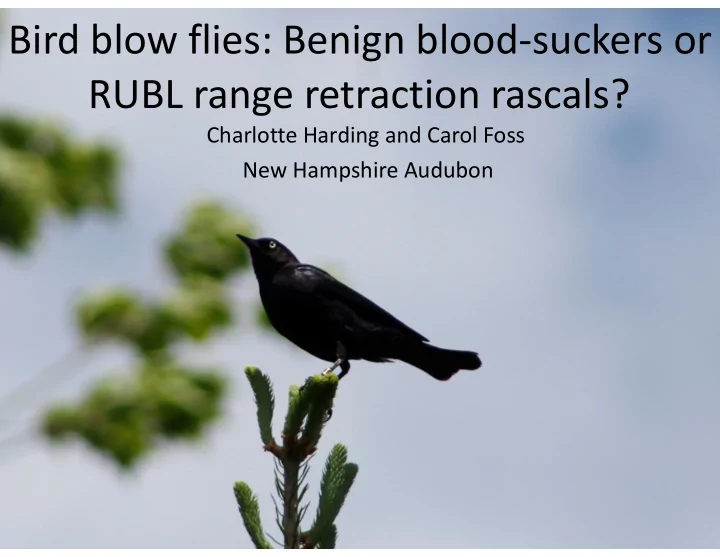

Bird blow flies: Benign blood-suckers or RUBL range retraction rascals? Charlotte Harding and Carol Foss New Hampshire Audubon
Findings from last year • Nestling found with larvae attached • 26/38 nests with P. shannoni puparia • Most severe: DIXI (31), MI14 (35), COBR (77)
Bird blow flies ( Protocalliphora ) 7-14 days or more depending on temp 24-48 hours www.bioflycontrol.co.uk
Bird blow flies ( Protocalliphora ) 7-14 days or more depending on temp 24-48 hours Molt www.bioflycontrol.co.uk
Bird blow flies ( Protocalliphora ) 7-14 days or more depending on temp Non-feeding 24-48 hours prepupal stage Molt Molt www.bioflycontrol.co.uk
Bird blow flies ( Protocalliphora ) 7-14 days Non-feeding 24-48 hours prepupal stage Molt Molt www.bioflycontrol.co.uk
Protocalliphora shannoni Rare in west • Intermediate stratum and • canopy Commonly associated with • American robins Other confirmed hosts: • – Red-winged blackbird, common grackle, eastern bluebird, gray catbird, jays (blue and gray), thrushes (hermit; Swainson’s, wood), sparrows (song and white-throated), cedar waxwing, house wren, yellow-rumped warbler *all IDs confirmed by T. Whitworth
2016 Field Season • Learn more about blow fly parasitism of RUBLs • What makes nests more or less susceptible to severe infestation? • Is blow fly parasitism decreasing RUBL nest success? • Is threat of blow fly parasitism increasing with warmer weather patterns? – Explosion of other blood-sucking ectoparasites
Our Approach • 2 nest camera setups • Monitored nest activity • Nests collected after fledging and sent for analysis • Rearing cages set up for 3 nests that had most severe infestations in 2015
Nest Analysis • 17/25 nests infested • 6 nests - P. shannoni only • 5 nests - P. metallica only • 6 nests - mixed infestations
Nest Analysis • 17/25 nests infested • 6 nests - P. shannoni only • 5 nests - P. metallica only • 6 nests - mixed infestations Protocalliphora metallica • Ubiquitous • Frequently occurs in marsh habitats and infests ground-nesters
Possible correlations • What makes nests more or less susceptible to blow fly infestation? – Nestling hatch date – Nest elevation – Nest latitude – Proximity to water sources – Proximity to roads
2015 2016
Future Directions Future Directions • Continue nest collection • Better-quality nest footage • Nestling telemetry • Anemia testing
Thank you! • Carol Foss • Terry Whitworth • Peter Mason • The 2016 RUBL field season team: Patti Wohner, Shannon Luepold, Cassandra LaVoie, Katrina Fenton and Grace Mitchum
COBR female eating eggshells
COBR nestlings getting fed
DIXI nestlings getting fed
Recommend
More recommend